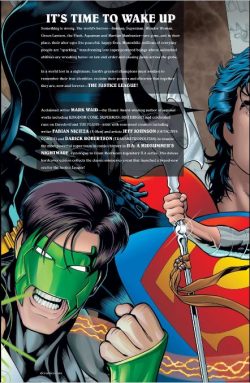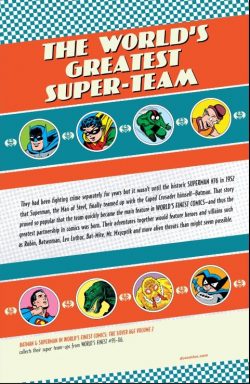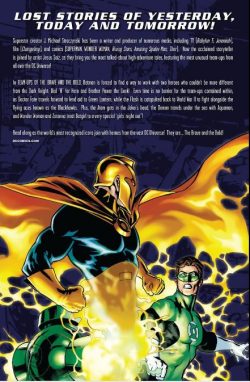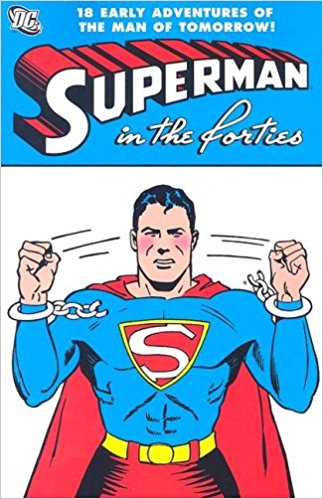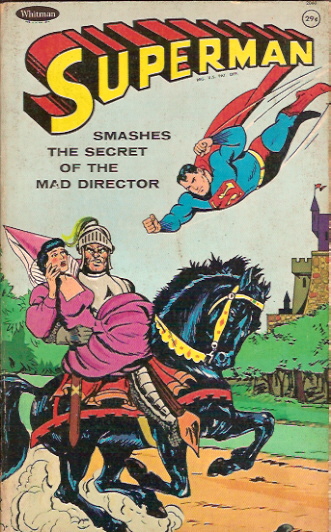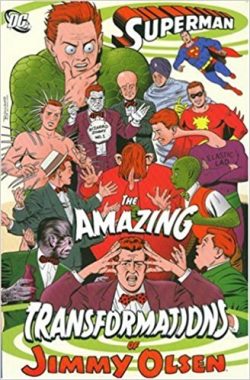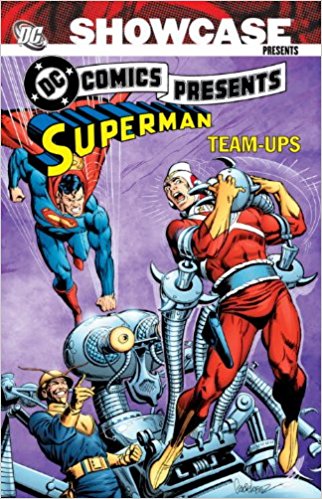
By Martin Pasko, Dave Michelinie, Len Wein, Paul Levitz, Cary Bates, Steve Englehart, Denny O’Neil, Gerry Conway, Mike W. Barr, Jim Starlin, Marv Wolfman, José Luis GarcÃa-López, Murphy Anderson, Curt Swan, Dick Dillin, Joe Staton, Rich Buckler & various (DC Comics)
ISBN: 978-1-4012-2535-3
As I’ve been inundating you with Superman stuff in this Anniversary year and celebrating the graphic literary device of team-ups this week, how could I let this superb collection go unremarked, especially as so much of the material remans inaccessible in more modern, full-colour compilations? Comics fans are all completists at heart, and until new editions or digital equivalents are released this is as good at it gets…
From the moment a kid first sees his second superhero the only thing he/she wants is to see how the new gaudy gladiator stacks up against the first. From the earliest days of the comics industry (and according to DC Comics Presents editor Julie Schwartz it was the same with the pulps and dime novels that preceded it) we’ve wanted our idols to meet, associate, battle together – and if you follow the Timely/Marvel model, that means against each other – far more than we want to see them trounce their archenemies in a united front…
The concept of team-up books – an established star pairing or battling (usually both) with less well-selling company characters – was far from new when DC awarded their then-biggest gun (it was the publicity-drenched weeks before the release of Superman: The Movie and Tim Burton’s Batman was over a decade away) a regular arena to have adventures with other stars of their firmament, just as Batman had been doing since the middle of the 1960s in The Brave and the Bold.
In truth, the Action Ace had already enjoyed the serial sharing experience once before, when World’s Finest Comics briefly ejected the Caped Crusader and Superman battled beside a coterie of heroes including Flash, Robin, Teen Titans, Vigilante, Dr. Fate and others (issues #198-214; November 1970 to October/November 1972) before the proper status quo was re-established.
This superbly economical monochrome collection re-presents the first 26 issues of the star-studded monthly and opens the show with a two-part thriller featuring Barry Allen, the Silver Age Flash who had also been Superman’s first co-star in that aforementioned World’s Finest Comics run.
‘Chase to the End of Time!’ and ‘Race to the End of Time!’ featured in DC Comics Presents #1 and 2 (July-August and September-October 1978), as scripter Marty Pasko and the utterly astounding José Luis GarcÃa-López (inked by Dan Adkins) rather reprised that WF tale. Here warring alien races trick both heroes into speeding relentlessly through the time-stream to prevent Earth’s history from being corrupted and destroyed.
As if that wasn’t dangerous enough, nobody could predict the deadly intervention of the Scarlet Speedster’s most dangerous foe, Professor Zoom, the Reverse-Flash…
David Michelinie wrote a tantalising pastiche of classic Adam Strange Mystery in Space thrillers for GarcÃa-López to draw and ink in ‘The Riddle of Little Earth Lost’ wherein the Man of Two Worlds and Man of Tomorrow foil the diabolical cosmic catastrophe scheme of a deranged genius to transpose, subjugate and/or destroy Earth and light-years distant planet Rann.
Len Wein came aboard to script the superb ‘Sun-Stroke!’ wherein the Man of Steel and the madly-malleable Metal Men join forces to thwart solar-fuelled genius I.Q. and toxic elemental menace Chemo after an ill-considered plan to enhance Earth’s solar radiation exposure provokes a cataclysmic solar-flare.
Sea King Aquaman is embroiled in ‘The War of the Undersea Cities’ (by Wein, Paul Levitz & Murphy Anderson) when his subjects re-open ancient hostilities with the mer-folk of undersea neighbour Tritonis, home of Superman’s old college girlfriend Lori Lemaris. Fortunately, cooler heads prevail when the deadly Ocean Master is revealed to be meddling in their sub-sea politics, after which ‘The Fantastic Fall of Green Lantern’ (Levitz, Curt Swan & Francisco Chiaramonte) sees the Man of Steel inherit the awesome power ring after Hal Jordan falls in battle against Star Sapphire.
Although triumphant against his female foe, Superman is subsequently ambushed by anti-matter warriors from Qward leading to ‘The Paralyzed Planet Peril!’ (#7, Levitz, Dick Dillin & Chiaramonte) wherein those aliens try to colonise Earth until the robotic Red Tornado swirls in to the rescue.
‘The Sixty Deaths of Solomon Grundy’ by Steve Englehart & Murphy Anderson co-stars Swamp Thing (at a time when the bog-beast still believed he was a transformed human and not an enhanced plant) searching the sewers of Metropolis for a cure to his condition, only to stumble onto a battle between the Man of Steel and the mystic zombie who was “born on a Mondayâ€â€¦
Marty Pasko returns to script the Joe Staton & Jack Abel illustrated ‘Invasion of the Ice People!’ wherein Wonder Woman assists in repelling an attack by malign disembodied intellects before another 2-part tale commences with ‘The Miracle Man of Easy Company’ (Cary Bates, Staton & Abel)…
Here a super-bomb blasts Superman back to World War II and a momentous meeting with indomitable everyman soldier Sgt. Rock, before the Caped Kryptonian returns home to battle a brainwashed and power-amplified Hawkman in ‘Murder by Starlight!’ (Bates, Staton & Chiaramonte).
DCCP #12 offered a duel between the Action Ace and New God Mister Miracle in ‘Winner Take Metropolis’ by Englehart, Richard Buckler & Dick Giordano before Levitz scripts an ambitious continued epic that begins with ‘To Live in Peace… Nevermore!’ (art from Dillin & Giordano), wherein the Legion of Super-Heroes prevent Superman saving a little boy from alien abduction to preserve the integrity of the time-line. It didn’t help that the lad was Jon Ross, son of Clark Kent’s oldest friend and most trusted confidante…
Driven mad by loss, Pete Ross risks the destruction of reality itself by enlisting the aid of Superboy to battle his older self in ‘Judge, Jury… and No Justice!’ (Levitz, Dillin & Giordano), after which the Man of Steel helps scientist-hero Ray Palmer regain his size-changing powers in ‘The Plight of the Giant Atom!’ (Bates, Staton & Chiaramonte).
Issue #16 finds Superman and Black Lightning battling a heartsick alien trapped on Earth foe millennia in ‘The De-volver!’ (Denny O’Neil, Staton & Chiaramonte) after which Gerry Conway, GarcÃa-López & Steve Mitchell herald the return of Firestorm in ‘The Ice Slaves of Killer Frost!’: a bombastic, saves-the-day epic which brought the Nuclear Man back into the active DC pantheon after a long hiatus.
Zatanna co-stars in the Conway, Dillin & Chiaramonte rollercoaster ride ‘The Night it Rained Magic!’; Batgirl helps solve the eerie mystery ‘Who Haunts This House?’ (O’Neil, Staton & Chiaramonte) and Green Arrow steals the show as always in the gripping, big-business-busting eco-thriller ‘Inferno from the Sky!’ by O’Neil, GarcÃa-López & Joe Giella.
DCCP #21 depicts the eclectic and eccentric detective Elongated Man as patient zero in ‘The Alien Epidemic’: a tense medical mystery by Conway, Staton & Chiaramonte, after which Mike W. Barr provides an effective science fiction doom-tale co-starring Captain Comet as the future-man endures ‘The Plight of the Human Comet!’ (art by Dillin & Frank McLaughlin).
‘The Curse Out of Time!’ (#23, O’Neil, Staton & Vince Colletta) affects two separate Earths, compelling Superman and Doctor Fate to defeat imps and ghosts before normality can be restored and the supernatural theme continues in a magnificent team-up with Deadman in #24 wherein Wein & GarcÃa-López revealed the tragic and chilling story of ‘The Man Who Was the World!’
The long unresolved fate of Jon Ross is happily concluded in the cunning and redemptive ‘Judgement Night’ with the enigmatic Phantom Stranger finagling and overcoming an insoluble, intolerable situation with Superman, courtesy of Levitz, Dillin & McLaughlin.
This stellar collection concludes with a spectacular return engagement for Green Lantern as Emerald Crusader and Man of Tomorrow battle each other and a trans-dimensional shape-shifter in ‘Between Friend and Foe!’; plotted and pencilled by Jim Starlin, scripted by Marv Wolfman and inked by Steve Mitchell.
These short, pithy adventures act as a perfect shop window for DC’s fascinating catalogue of characters and creators; delivering a breadth and variety of self-contained, exciting and satisfying entertainments ranging from the merely excellent all the way to utterly unmissable. This book is the perfect introduction to the DC Universe for every kid of any age and a delightful slice of the ideal Costumed Dramas of a simpler, more inviting time…
© 1978, 1979, 1980, 2009 DC Comics. All Rights Reserved.


